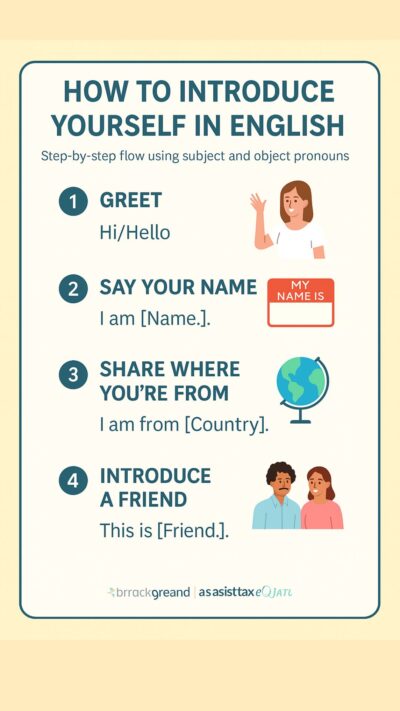Learn to make introductions in English with subject & object pronouns through conversation, dictation, music, and a quick quiz.

Affiliate Disclosure
Guess what? When you click and buy through our links, you’re doing more than improving your game. You’re supporting us in a way that doesn’t cost you extra but helps us keep bringing you the best drills and tips. It’s a slam dunk for both of us!
Making introductions is one of the first skills English learners need. Whether you’re meeting a new friend, introducing yourself in class, or connecting at work, you’ll use subject and object pronouns every day.
Summary
- Learn subject vs. object pronouns
- Practice making introductions
- Improve listening with dictation and song
- Test your knowledge with a quiz
Table of Contents
- What Will You Learn in This Lesson?
- What Are Subject and Object Pronouns?
- How Do You Introduce Yourself in English?
- How Can Dictation Improve Your English?
- How Can Songs Help You Learn Pronouns?
- How Can You Test Your Knowledge of Pronouns?
- Why Is Practicing Introductions Important?
- Where Can You Find More Practice?
What Will You Learn in This Lesson?
This guide covers the basics of subject and object pronouns, gives you simple introduction lines, and shares practice strategies to remember them. Whether you’re learning for travel, work, or fun, you’ll pick up tips that make English introductions a breeze.
This post will help you:
- Understand subject and object pronouns
- Introduce yourself and ask basic questions
- Practice with listening and speaking activities
- Test yourself with a short quiz
What Are Subject and Object Pronouns?
Subject pronouns do the action in a sentence. Object pronouns receive the action.
Subject pronouns: I, you, he, she, it, we, they
Object pronouns: me, you, him, her, it, us, them
| Subject | Object | Example Sentence |
|---|---|---|
| I | me | I am Robert. She knows me. |
| You | you | You are a student. I see you. |
| He | him | He is my friend. I talk to him. |
| She | her | She is happy. We help her. |
| We | us | We are classmates. They teach us. |
| They | them | They are from China. I like them. |
| It | it | It is sunny. I love it. |
Want to practice these in real conversation? Try a free lesson with italki.
How Do You Introduce Yourself in English?
Start with your name using a subject pronoun: “I’m Sam.” When introducing friends, use object pronouns: “This is Sarah. Have you met her?” Switching between subject and object forms helps your introductions sound natural.
Basic introduction patterns:
- “I am [Name].”
- “I am from [Country].”
- “This is [Friend].”
Practice swapping pronouns:
- “He is my teacher.”
- “We are students.”
- “She helps me.”
Want interactive practice? Rocket Languages has audio lessons on introductions and pronouns.
How Can Dictation Improve Your English?
Dictation, listening and writing what you hear, also reinforces pronoun use. Try writing short dialogs to introduce imaginary friends and get even more practice. Reading aloud can also help lock in pronoun use.
Dictation connects listening with writing. Listen carefully, write what you hear, then check for accuracy.
Example sentences:
- I am a student.
- She likes him.
- They are from Peru.
- The teacher helps us.
For daily audio practice, try EnglishClass101.
How Can Songs Help You Learn Pronouns?
Songs with lyrics that repeat “he,” “she,” or “they” make pronoun patterns stick in your memory.
Music is a powerful way to remember English. Listen to “I’d Like To Get To Know You” and fill in the missing pronouns.
Download the worksheet
Apps like Mondly also use interactive exercises for daily practice.
How Can You Test Your Knowledge of Pronouns?
Try this short self-check quiz:
- True/False: “They is a subject pronoun.”
- Multiple Choice: Which is correct? (I like her. / Me like she.)
- Matching: I → me, He → him, We → us.
- Short Answer: Write a sentence with “they.”

Why Is Practicing Introductions Important?
Making introductions is one of the most useful skills in English. With practice, you’ll feel confident telling people your name, your country, and introducing friends or classmates.
Using pronouns correctly makes your introductions sound smoother and more confident. Practicing often really helps these tiny words feel more natural every time you speak English, and over time, you’ll spot mistakes and fix them easily.
What do you think?
How do you introduce yourself in English?
Has this lesson helped you? Do you have questions or comments
Share your answer in the comments below.
I’d love to hear from you.
I always reply.
Where Can You Find More Practice?
- Get live speaking practice with italki
- Build listening skills with EnglishClass101
- Learn with audio lessons at Rocket Languages
- Train daily with Mondly
- For printable worksheets and full activities, check out my Making Introductions Lesson on TPT
LearnEnglish #ESLLesson #EnglishGrammar #AdultESL #EnglishPronouns #SpeakEnglish


This is such a clear and practical guide—breaking down subject and object pronouns with examples makes it easy for learners to actually use them in real conversations, not just memorize them. I especially liked the tips about using songs and dictation, since those add a fun twist to practice and help the patterns stick.
One question I had: when introducing yourself in more formal situations (like a job interview), are there specific pronoun mistakes that learners should be especially careful to avoid?
Hi Jenny, thanks for your comments. Regarding your question, no, I can’t think of any specific pronoun mistakes, although it’s important to not be too informal, at least in the beginning.
KBob